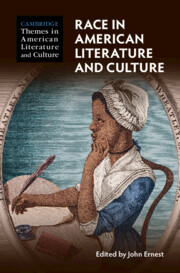Book contents
- Race in American Literature and Culture
- Cambridge Themes in American Literature and Culture
- Race in American Literature and Culture
- Copyright page
- Contents
- Contributors
- Acknowledgments
- Introduction
- Part I Fractured Foundations
- Part II Racial Citizenship
- Part III Contending Forces
- Part IV Reconfigurations
- Part V Envisioning Race
- Chapter 15 Picturing Race
- Chapter 16 “The Man That Was a Thing”
- Chapter 17 Locating Race
- Chapter 18 De-forming and Re-making
- Part VI Case Studies
- Part VII Reflections and Prospects
- Index
Chapter 18 - De-forming and Re-making
Bernardine Evaristo’s Girl, Woman, Other and the Multifocal Decolonial Novel
from Part V - Envisioning Race
Published online by Cambridge University Press: 26 May 2022
- Race in American Literature and Culture
- Cambridge Themes in American Literature and Culture
- Race in American Literature and Culture
- Copyright page
- Contents
- Contributors
- Acknowledgments
- Introduction
- Part I Fractured Foundations
- Part II Racial Citizenship
- Part III Contending Forces
- Part IV Reconfigurations
- Part V Envisioning Race
- Chapter 15 Picturing Race
- Chapter 16 “The Man That Was a Thing”
- Chapter 17 Locating Race
- Chapter 18 De-forming and Re-making
- Part VI Case Studies
- Part VII Reflections and Prospects
- Index
Summary
This essay describes Bernardine Evaristo as exemplary of a cohort of contemporary writers who are self-consciously pushing the boundaries of content and form to amplify the voices and perspectives of marginalized persons. Laying out in a systematic way the features and goals of the multifocal decolonial novel, this article takes Evaristo’s Booker Prize–winning novel Girl, Woman, Other (2019) as a case study. We show that Evaristo uses a multifocal narrrative structure to distribute narrative attention and character space more or less equally among a large number of characters, even as she pays careful attention to the characters’ networks of interaction and affiliation. Such a narrative structure demonstrates that there are always multiple “worlds of sense” – or domains of intelligibility – that make up a shared social-natural world; they further effectively illustrate the ecological and interconnected nature of that world. In this way, multifocal narrative novels provincialize the so-called universal perspective without falling into epistemological or ontological relativism. Through the use of a multifocal narrative structure and the poetic technique of caesura, Evaristo deploys the resources of literary fiction to document an obscured Black British historical past while harnessing the imagination to reshape an understanding of that past.
Keywords
- Type
- Chapter
- Information
- Race in American Literature and Culture , pp. 292 - 306Publisher: Cambridge University PressPrint publication year: 2022

